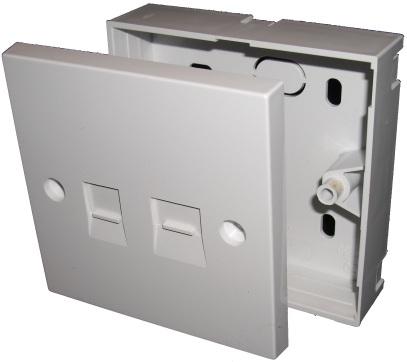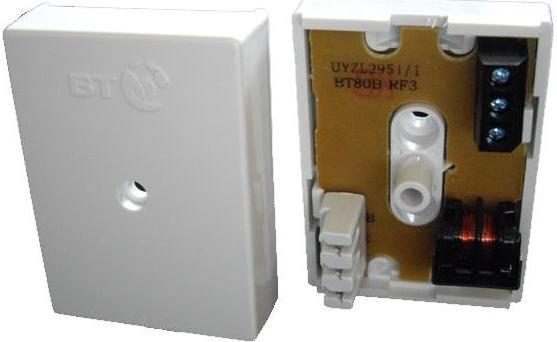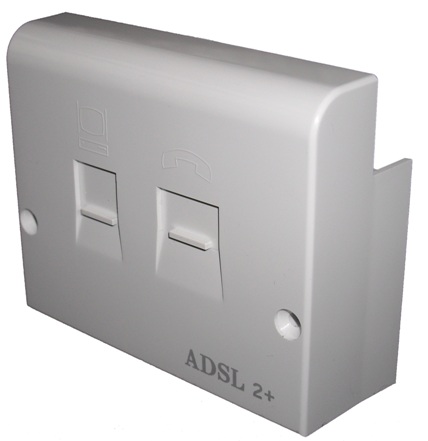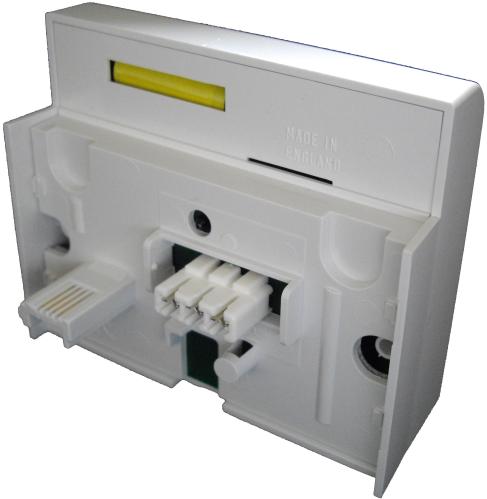In our last post covering the NTE5 master socket we mentioned SSFP's or Service Specific Face Plates. In short this little buzz term covers what we commonly call a filtered faceplate or ADSL/vDSL faceplate. If you have broadband (ADSL or vDSL) then there are a few reasons why you should really consider one of these. Over the years we've sold thousands of these little gizmo's, they all do basically the same thing, the main types are as follows...
NTE2000 https://www.bttorj45.com/vdsl-adsl-nte-filtered-faceplates/nte2000-filtered-faceplate/
The NTE2000 is as old as ADSL itself! Earlier versions had ADSL V 1.0 printed on them but later on in production this was changed to ADSL 2+. This really was nothing more than a marketing exercise as the filter design was unchanged. This filter simply replaces the lower front of the NTE5 and filters any extension wiring so no need to have plug in filters around the house! Installation is simple, remove the NTE5 lower front plate, note which wires are going to 2, 3 & 5, remove the wires & reinstall on the new NTE2000 using an IDC tool. Removing the need for plug in filters isn't the main benefit mind, remember when we covered the NTE5 & explained how the bell wire filter improves connections by isolating it from the broad band signal? Well, a filtered faceplate takes this a step further. Any copper wiring between you and the exchange adds to your line length, the longer your line the slower the download speed. A filtered faceplate isolates any extension wiring from the broad band signal so in effect shortening your line 
But there is a downside  With this fitted you can only plug your modem or router into the socket on the faceplate as all extensions are now filtered (filtered means the broadband signal has been taken away), now a lot of people have their master socket in a hallway and really don't want (or can't due to lack of power socket!) to have their router in there. Fear not as the NTE2005 fixes this issue...
With this fitted you can only plug your modem or router into the socket on the faceplate as all extensions are now filtered (filtered means the broadband signal has been taken away), now a lot of people have their master socket in a hallway and really don't want (or can't due to lack of power socket!) to have their router in there. Fear not as the NTE2005 fixes this issue...
NTE2005 https://www.bttorj45.com/vdsl-adsl-nte-filtered-faceplates/nte2005-filtered-faceplate/
Those paying attention will notice a subtle difference - the IDC block on the rear has more terminals and is BLUE! For extensions carrying just voice (so you just need a telephone on them) the wiring goes to 2, 3 & 5 as before. Now the added part, for a broadband extension you wire a pair of cables to A & B on the blue IDC block. At the other end you can either terminate to one of these (connect to 2 & 5):-

or to a standard secondary BT socket (again, connect to 2 & 5). If using a standard BT socket you will need a plug in filter. Not because the router or modem requires it but simply because the lead will be fitted with an RJ11 plug & that isn't going to plug into a BT socket. The filter is just acting like an adaptor (with the added benefit that should you require a phone where the modem plugs in you can also have that too, just plug it into the BT socket on the filter  )
)
Now as mentioned any cabling added to the line can affect the broadband speed so keep these points in mind :-
- Keep the extension for the broadband as short as possible
- Use high quality COPPER twisted pair cable such as CW1308 specification
- Don't bend the cable or crush it when clipping
BT Openreach™ ADSL/vDSL I Plate https://www.bttorj45.com/vdsl-adsl-nte-filtered-faceplates/bt-mk3-vdsl-faceplate/


This faceplate was introduced when vDSL (BT Infinity) came to the market. It's a completely new design but in quite a short space of time has been revised a few times. The major difference is how it fits to the NTE5, rather than replace the original lower front half it fits in between, that's where the I in its name comes from - I for Interstitial which simply means in between
 This faceplate has a revised design which is required for the frequencies vDSL operates at. There have been 3 versions to date :-
This faceplate has a revised design which is required for the frequencies vDSL operates at. There have been 3 versions to date :-
- The Mk1, this was never termed the Mk1 and has no writing on it at all. This was the only version also available as an OEM unbranded version (all other versions have only been made with Openreach branding)
- The Mk2 added what is called a REIN ( Repetitive Electrical Impulse Noise).
- The Mk3 changed the REIN filter specification
 https://www.bttorj45.com/bt-junction-boxes/bt80brf3-junction-box/
https://www.bttorj45.com/bt-junction-boxes/bt80brf3-junction-box/This little junction box fits upstream on the NTE5 master socket & filters out electrical noise. There is a downside in so much that it can lower sync speed but as this is a side affect of line stability it's usually better (better to have a stable slightly...



